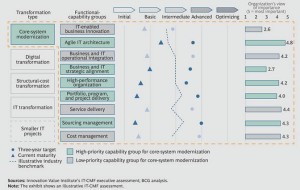The Other Technology Strategy Every IT Leader Needs. To build advantage, organizations must do more than just change. They must transform. As technology’s role in business becomes ever more important, transformations will increasingly be underpinned by significant technology programs. In such technology-enabled transformations, IT leaders need two different strategies to ensure success.
One is a strategy for delivering significant changes, such as digitizing operations, replacing or modernizing systems, and standardizing infrastructure and applications. As part of this strategy, IT leaders must also develop the necessary tactics, multiyear roadmaps, and plans to deliver the technology to support the business transformation.
The second strategy, which is often overlooked, must ensure that the IT organization itself has the right functional capabilities to drive and sustain the transformation. Organizations that reap material benefits from transformations are those with the right organizational capabilities in place—the right team, organization, processes, tools, and culture—to become truly world class. (See Transformation: The Imperative to Change, BCG report, November 2014.) In a technology-enabled transformation, the maturity of the IT team’s capabilities is especially important.
To get their organizations fit to support a transformation, IT leaders must develop a strategy and design an explicit plan to assess and develop the capabilities they need to make the transformation successful. The plan must consider how well IT management functions and disciplines are embedded and executed across the business and encompass functions such as IT planning, sourcing, delivery, budgeting, and benefits realization.
The Importance of a Fit IT Function
When technology-enabled transformations fail, they fail hard. Average performance is not good enough. In most cases, that failure arises not because intent or talent is lacking but because the IT organization is not fit to complete the multiyear marathon that a transformation represents. Common weaknesses include inadequate management of the portfolio, program, and projects, which can erode the full benefits of the transformation, and poor capabilities in managing vendors and contracts, which can allow costs and scope to spiral out of control. An unfit IT organization can jeopardize a technology-enabled transformation and with it benefits worth hundreds of millions of dollars. In contrast, fit IT organizations deliver transformation programs more consistently and predictably, make better trade-offs and resource-allocation decisions, and work more effectively and efficiently internally and with third parties, including vendors and system integrators.
How to Get Fit for Transformation
To develop their fit, transformation-ready IT strategy, leaders must answer three questions:
Which specific capabilities are needed to support the transformation? Different types of transformation require different strengths.
How good are my capabilities today, and how good do they need to be? Organizations should identify where, and how much, muscle is required to reach the desired target.
What is the right way to improve capabilities? Leaders must define a manageable set of clear, outcome-focused initiatives to improve capabilities in the areas where they are needed most.
….
What is the right way to improve capabilities? Improving organizational capabilities is hard. It typically takes 18 to 24 months of focused, well-resourced, and disciplined effort to lift a single capability area by one maturity level. This effort will include embedding accountabilities, processes, tools, and decision making.
The IT-CMF defines the set of activities an organization must undertake to reach the next level of maturity. For example, to move up from level 2 to level 3 in project and program management, where IT contributes directly to business value rather than just being a service provider, requires the following steps:
- A move from rudimentary project- and program-management disciplines that are inconsistently applied across the IT organization to consistent, well-defined, organization-wide project- and program-management approaches applied everywhere
- A move from basic and project-specific benefit assessment and tracking approaches that are applied inconsistently and only for some projects to a standard, enterprise-wide discipline for defining IT and business benefits and tracking them against project milestones
- A move from simple project budgeting done by project managers in isolation and with inconsistent detail, time frames, and reporting to project budgets that are set and monitored in a way that enables regular comparison of project budgets across the entire IT project portfolio and at both top and detailed levels
Typically, these activities will translate into a portfolio of three to ten initiatives, with time frames ranging from 3 months for rapid, quick-win enhancements to 18 to 24 months for more-structural reforms. The work needs to be supported by clear accountabilities, milestones, and definitive metrics that can demonstrate improvement in functional capabilities. Including these initiatives within the wider organization’s project portfolio in terms of getting approval and funding is essential to making sure they get done. Regular reporting on progress helps to maintain momentum by securing strong commitment and decisiveness from the most senior leaders of the IT business.
…
Organizations that systematically strengthen their most critical functional IT capabilities early in a transformation are consistently better at delivering on the promised value. Indeed, an explicit and early focus on the most critical capabilities and the right investments in resources, effort, and management attention are what separates success from failure.
While the task may seem daunting, in practice, we have seen highly committed organizations use reliable and tested tools like the IT-CMF to enhance their most critical transformation capabilities in the course of just a few months. In this way, organizations can get fit quickly and lay the foundation for a successful business transformation.
Authors: Andrew Arcuri, Principal, Sydney; Richard Helm, Partner & Managing Director, Sydney
